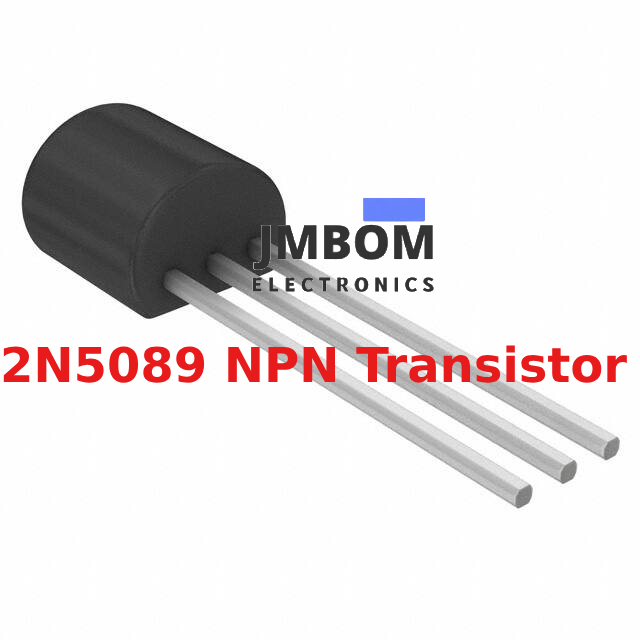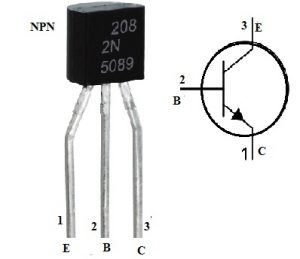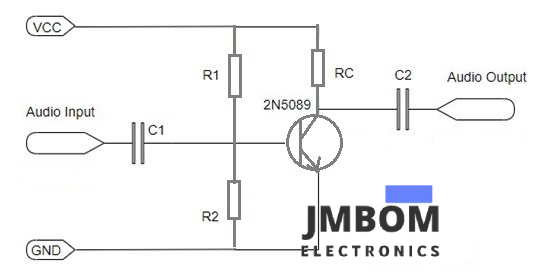

2N5089 NPN Transistor: Overview, Pinout, and Common Uses
Catalog
What Is the 2N5089 Transistor?Pinout and SymbolKey Features and Specifications of the 2N5089 NPN TransistorWhy Choose the 2N5089 Transistor?Applications and Usage of the 2N5089 TransistorWhere to Use the 2N5089 NPN TransistorAmplification ApplicationsFrequently Ask QuestionsRelated ArticlesThe 2N5089 is a high-gain NPN bipolar junction transistor (BJT) commonly used in low-power amplification and switching applications. In saturation mode, it acts as a switch, while in the active region, it functions as an amplifier. Built on silicon technology, the 2N5089 is specifically designed to amplify weak audio signals, delivering a stronger output signal at the collector — ideal for low-power audio systems.
Due to its high gain and low noise characteristics, this transistor is widely used in audio preamplifiers and signal processing circuits. It can handle a continuous collector current of up to 50 mA. In this guide, we’ll explore the 2N5089’s pin configuration, functionality, and typical applications.

What Is the 2N5089 Transistor?
The 2N5089 is a general-purpose NPN BJT housed in a compact TO-92 package, manufactured by various electronic component suppliers. It's engineered to amplify both analog and digital signals, making it suitable for a wide range of low-noise amplification tasks. Whether you're boosting weak signals in audio equipment or using it in other signal processing circuits, the 2N5089 offers high gain and reliability.
When a standard low-noise transistor is used to amplify a low-gain signal, the resulting output often includes unwanted noise along with the amplified signal. This happens because the transistor amplifies both the signal and the existing noise. However, the 2N5089 stands out due to its low-noise performance, offering a noise figure of just 2.0 dB, which helps maintain signal clarity during amplification.
In addition to its use in amplification, the 2N5089 can also function effectively as a switch for controlling loads under 100mA. It’s also suitable for RF applications operating at frequencies below 50 MHz, making it a versatile component for both analog and digital circuits.
Pinout and Symbol
The 2N5089 transistor comes in a standard TO-92 package and features three terminals: Emitter, Base, and Collector. The diagram below illustrates the transistor’s symbol and pin configuration, with a brief explanation of each terminal’s function.

2N5089 NPN Transistor Pin Configuration
Pin Configuration
- Pin 1 (Emitter): This is the emitter terminal, typically connected to ground in most configurations.
- Pin 2 (Base): This is the control terminal that regulates current flow between the collector and emitter.
- Pin 3 (Collector): This is the collector terminal, where the amplified output or switched load is connected.
Key Features and Specifications of the 2N5089 NPN Transistor
- Package Type: TO-92
- Transistor Type: NPN
- Maximum Collector Current (IC): 100 mA
- Maximum Collector-Emitter Voltage (V<sub>CE</sub>): 25 V
- Maximum Collector-Base Voltage (V<sub>CB</sub>): 30 V
- Maximum Emitter-Base Voltage (V<sub>EBO</sub>): 3 V
- Maximum Collector Dissipation (P<sub>C</sub>): 625 mW
- Transition Frequency (f<sub>T</sub>): Up to 50 MHz
- DC Current Gain (h<sub>FE</sub>): Ranges from 400 to 1200
- Operating and Storage Temperature Range: -55°C to +150°C
- Typical Continuous Collector Current: 50 mA
Surface-Mount Equivalent and Substitutes
The surface-mount equivalent of the 2N5089 is the MMBT5089, which comes in a SOT-23 package.
Other comparable or replacement transistors include:
2N5088, SS9014, BC550, BC548, BC547, BC549, and equivalents such as MPS6532, MPS650, MPSW0, MPSH10, ZTX690B.
Why Choose the 2N5089 Transistor?
There are several compelling reasons to use the 2N5089 transistor in your designs:
- Excellent low-noise performance, ideal for audio and signal processing circuits
- High current gain (hFE), reducing the need for extra amplification stages
- Reliable switching behavior for small loads
- Compatible with both analog and RF circuits (below 50 MHz)
- Easily available in both through-hole (TO-92) and SMD (SOT-23) versions
Applications and Usage of the 2N5089 Transistor
The 2N5089 NPN transistor is well-suited for low-side switching applications, where the transistor is placed between the load and ground. In contrast, PNP transistors are typically used for high-side switching, where the transistor sits between the power supply and the load.
The 2N5089 offers a collector-emitter breakdown voltage of up to 25V, and a collector-base breakdown voltage of up to 30V, making it reliable for moderate voltage environments. It supports a continuous collector current of up to 50 mA, which is ideal for low-power circuit designs.
Thanks to its high DC current gain (hFE), the 2N5089 is commonly used in audio amplification circuits and other signal amplification applications where low noise and high gain are important. Additionally, it performs well in switching circuits, making it a versatile choice in various analog and digital systems.
Using the 2N5089 as an Amplifier (Circuit Diagram Overview)
The 2N5089 can be configured as either a switch or an amplifier. In this example, we focus on its use as a signal amplifier using the common-emitter configuration. This setup is popular because it provides significant voltage gain, making it ideal for boosting weak input signals in audio and sensor-based circuits.

Amplifier Circuit using 2N5089 NPN Transistor
In a typical amplifier circuit:
- The input signal is applied to the base through a coupling capacitor.
- The emitter is grounded through a resistor to stabilize the bias.
- The collector connects to the supply via a load resistor, and the amplified output is taken from the collector.
This simple yet effective configuration is widely used in preamp stages, signal conditioning, and other low-noise amplification needs.
In the circuit above, the 2N5089 transistor is shown in a typical configuration used for audio amplification. The coupling capacitor labeled C1 passes the AC audio signal to the base of the transistor while blocking any DC components. The DC blocking capacitor, C2, is placed at the output to prevent DC from reaching the next stage in the circuit.
The collector resistor, marked as RC, plays a key role in determining the circuit’s frequency response and voltage gain. Adjusting the value of RC changes the collector current (I<sub>C</sub>), which in turn influences the gain and overall behavior of the amplifier.
The resistors R1 and R2 form a voltage divider network that provides proper biasing to the base of the transistor, ensuring it stays in the active region during operation.
When an audio input signal is applied to the base terminal, and an appropriate DC voltage is supplied to the collector, the transistor enters its active mode. In this state, the 2N5089 amplifies the weak audio signal, making it suitable for further processing or output through speakers or other audio components.
In the circuit described above, the audio input is an AC signal. The primary role of the coupling capacitors is to prevent signal distortion by blocking unwanted DC components, which could otherwise affect audio quality. These capacitors also help maintain a high input impedance, particularly at lower frequencies, preserving the integrity of the input signal.
At the output, a capacitor is connected in series to eliminate any residual DC offset, ensuring that only the amplified AC signal is passed to the next stage. The RC resistor (connected to the collector) regulates the collector current, directly influencing the amplifier’s voltage gain and frequency response.
As a result, a weak radio or audio signal, when passed through the 2N5089 NPN transistor, emerges as a clean, amplified signal. This makes the transistor especially useful in low-noise audio systems, such as preamplifiers, radio receivers, and other audio signal amplification applications.
Where to Use the 2N5089 NPN Transistor
The 2N5089 is ideal for a wide range of low-noise and low-power applications. Its high gain and low noise figure make it especially suitable for sensitive signal processing. Typical applications include:
Amplification Applications
- Audio amplifiers
- Audio preamplifiers
- Hi-Fi (High-Fidelity) audio systems
- Voice recorders and audio recorders
- Audio tone control circuits
- Low-noise signal amplification
- High AF (audio frequency) systems
- Signal modulation and conditioning
- Miscellaneous small-signal amplification
- Audio amplifier stages
Switching Applications
- Load switching up to 100 mA
- General-purpose switching circuits
- Sensor-triggered switching systems
- Temperature detection circuits
- Low-frequency RF switching (below 50 MHz)
Circuit Configurations
- Push-pull amplifier circuits
- Push-pull output stages
- Common-emitter amplifier topologies
Other Uses
- Radio receiver circuits
- Sensor-based signal conditioning
In summary, the 2N5089 NPN transistor is a silicon-based device primarily designed for amplification applications, especially in audio systems. It operates in two distinct modes:
- In saturation mode, it functions as a switch, turning current flow fully on or off.
- In the active region, it acts as an amplifier, boosting weak input signals into stronger outputs.
This makes the 2N5089 a versatile component for both low-noise amplification and switching tasks in various analog and digital circuits.
Question for You:
What is the primary function of an amplifier?
➡️ An amplifier increases the strength (amplitude) of a weak input signal without altering its original waveform, making it suitable for driving speakers, transmitting data, or processing signals.
Frequently Ask Questions
What Is an NPN Transistor Used For?
NPN transistors are widely used in circuits where current needs to flow from a load into the transistor—commonly known as low-side switching. Key applications include:
- Signal amplification (especially when paired in Darlington configurations to boost weak signals)
- Switching circuits (e.g., turning on loads like LEDs or relays)
- Push-pull amplifier stages in audio systems
- Digital and analog circuits requiring fast switching and low noise
Can I Replace One Transistor with Another?
Not always. You can’t just swap any transistor for another—even if they look similar. However, finding a suitable replacement is usually easier than replacing a CPU or integrated chip. A proper substitute must match the original transistor's:
- Pin configuration
- Polarity (NPN or PNP)
- Voltage and current ratings
- Gain (hFE) and switching speed
What Is the 2N2222 Transistor?
The 2N2222 is a popular general-purpose NPN BJT used in low- to medium-power applications. It’s commonly found in:
- Signal amplifiers
- Switching circuits
- Basic DIY electronics
Originally packaged in a TO-18 metal can, it’s valued for its reliability, decent speed, and handling of moderate current loads.
What's the Difference Between the S8050 and S8550 Transistors?
- S8050 is an NPN transistor: the circuit is activated (turns on) when a high-level signal is applied.
- S8550 is a PNP transistor: the circuit is activated (turns on) when a low-level signal is applied.
Both are commonly used in basic switching and amplification circuits but behave differently based on logic level.
Should I Use an NPN or PNP Transistor?
Choose based on your application’s current path:
| Use Case | Recommended Transistor Type |
|---|---|
| Low-side switching | NPN |
| High-side switching | PNP |
| High-speed digital use | NPN |
| Complementary circuits | Both (e.g., push-pull) |
- NPNs are more common and generally preferred for most low-voltage logic and switching.
- PNPs are needed where the load is between the transistor and ground.
What Happens If a Transistor Fails?
A faulty transistor can cause:
- Device slowdown or malfunction
- Failure of signal amplification or switching
- Intermittent or total circuit breakdown
In critical circuits, one failed transistor can affect the entire system's stability or function.
How Do I Choose a Replacement Transistor?
To select a proper replacement:
- Match transistor type (BJT or FET, NPN or PNP)
- Ensure similar or better voltage and current ratings
- Check package type and pinout
- Match gain (hFE) and frequency response if the transistor is used in analog/RF circuits
Always consult a datasheet or use an online transistor equivalency tool if unsure.
What Is the Most Commonly Used NPN Transistor?
One of the most widely used NPN transistors is the 2N3904. It's perfect for:
- Driving small loads (up to 200 mA)
- General-purpose switching
- Interfacing with logic-level signals
- Low-noise amplification
It supports voltages up to 40V and is ideal for hobby projects, educational kits, and small embedded systems.
Related Articles
Crankshaft Position Sensor: Overview, Circuit Function& Comparison with Camshaft Sensors
Inverting Summing Amplifier: Circuit Diagram,Operation and Formula
Active Bandpass Filter: Overview, Types,Q Factor & Applications
Passive High-Pass Filter: Overview, Circuit Design & Transfer Function
Differential Pressure Sensors: Working Principle, Interfacing,Testing Methods and Common Issues
Voltage Amplifier: Circuit Design, Gain, vs. Power Amplifier, and Key Applications
Resistor-Transistor Logic (RTL):Operation, Features, and Applications
Diode-Transistor Logic (DTL): Circuit Design,Truth Table, and Applications
Subscribe to JMBom Electronics !













